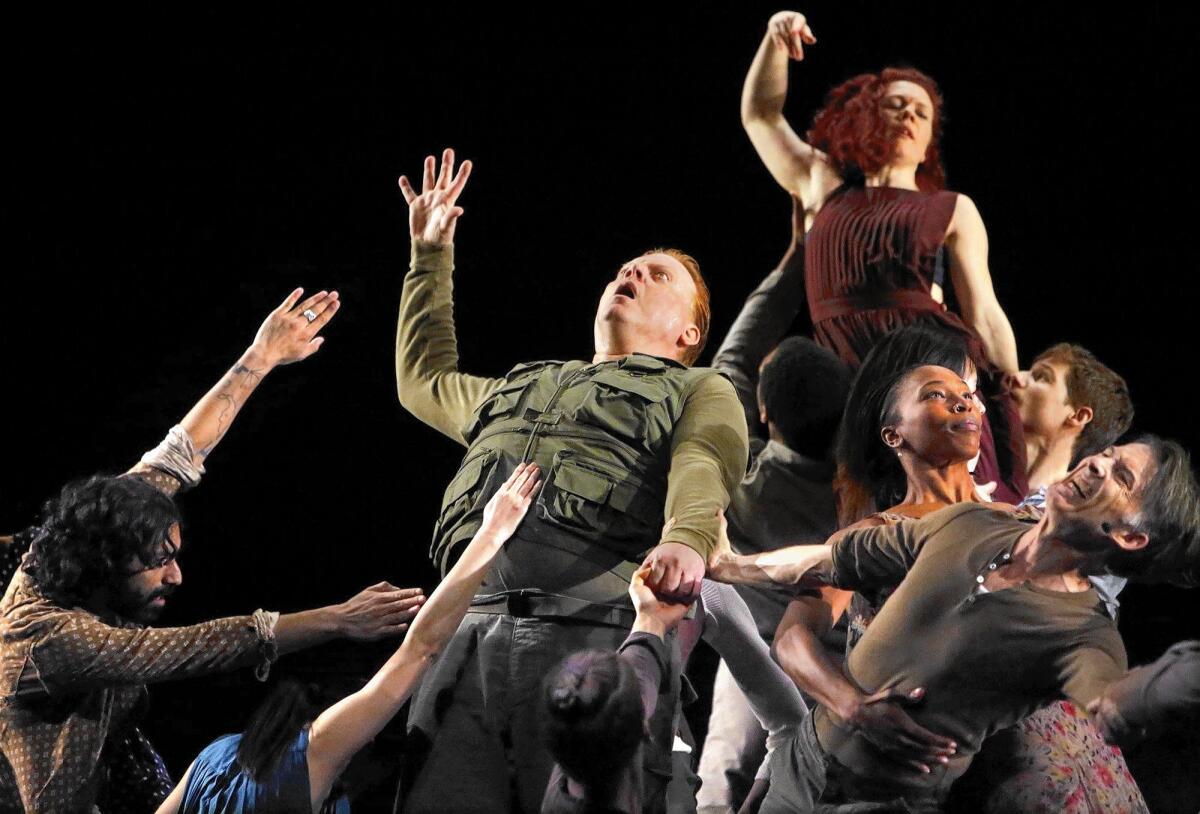Review: ‘A Rite’ powerfully reveals fragility of Stravinsky’s work

- Share via
When used simply as marketing tools, classical music anniversaries resemble the fast-food industry. And this has been no more musically unhealthful than the “Rite of Spring” centennial two years ago.
Stravinsky’s ballet may have revolutionized rhythm and caused a riot at its Paris premiere in 1913. But the ritual glut of anniversary “Rite” performances — along with such numbing offerings as a CD set of 38 recordings of the ballet — made a piquant score seem as quaint as comfort food.
“A Rite,” which Center for the Art of Performance at UCLA presented Friday night at Royce Hall, may have been the meaningful exception in 2013. An unusual dance and theater collaboration by the Bill T. Jones/Arnie Zane Dance Company and SITI Company, it meant to challenge the “Rite.” “Challenge” is too mild for the result. The collaborators fought with Stravinsky, tradition and, better still, with one another.
Jones’ original idea had been a backstage performance of the ballet, which the audience would not see, followed by the two companies on stage, exhausted, and dealing with the implications.
That proved obviously impractical. But the 65-minute piece, which had its premiere two years ago in North Carolina at a “Rite” academic conference and festival, did wind up beginning at the end, with the lethal frenzy of the final “Sacrificial Dance,” minus Stravinsky’s final chord. A shell-shocked soldier then walks on carrying a Walkman, on which is barely heard the score’s opening bassoon solo.
The intent of Jones, who (along with Janet Wong, his company’s associate artistic director) created the choreography, and of director Anne Bogart, who heads the SITI theater troupe, was to carry on where Stravinsky left off, but with Stravinsky’s score cubistically cut up.
After the opening, the order of the ballet was mostly followed. Parts of different recordings — historic and modern — were used for different sections. The music could be radically altered. Versions of the “Rite” came from jazz or the Stravinskyan rock trance of Birdsongs of the Mesozoic. Members of both companies sometimes sang “Rite” melodies in impressive contrapuntal exaltation or clapped out “Rite” rhythms. A Taiwanese dancer, I-Ling Liu, added surprising Chinese opera vocal inflections to “Spring Rounds.” Someone now and then tapped out a one-finger “Rite” tune on an old upright wheeled on stage.
None of this came about easily. In a refreshingly frank post-show conversation, Jones admitted that he lost his cool at the first rehearsal, causing the sound designer, who had skillfully picked the recordings, to quit in anger.
But this loss of cool is also what adds to the final production’s power. One aspect of “A Rite” is Jones’ coming to terms with history. A black choreographer, he contends with a composer who exploited jazz, keen on its rhythms but not its musical art.
Bogart’s company acts as a guide through time and Stravinsky. The shell-shocked soldier (Will Bond) recited World War I poetry and stuttered incoherently, showing Stravinsky’s irregular rhythms as mirroring the poisonous irregularity of 20th century violence.
SITI’s Ellen Lauren portrayed a reassuringly folksy and effusive musicologist, showing Stravinsky as a liberator of the spirit by winningly liberating her own with Jones’ dancers.
The “Rite” had celestial implications too, and Stephen Duff Webber, as a scientist, reclined on the ground and contemplated the cosmos.
The two companies remained distinct, but dancers spoke and actors moved. All were exceptionally musical and revealed a “Rite” suited for a joyfully danced Charleston and a “Rite” capable of accompanying mass murder.
In the end, “A Rite” is the “Rite” as the soundtrack of the past century, a small ceremony not of what Stravinsky did but what we, in our agony and ecstasy, have done to Stravinsky and one another.
The revelation, then, of “A Rite” is the ultimate fragile beauty of the “Rite.” That was heard in a Japanese poem about spring (“I want to dip my hand into the sky’s blue”). A dancer glided across tables, placed in front of each foot and then quickly removed, insinuated insubstantiality. She seemed to float in air, but she also made the observer aware that she could, at any second, fall.
The fall came later, when a World War I soldier morphed into a crazed American sniper. After his spray of bullets, everyone fell. That was the final image on stage.
There is no “Rite” reconstruction in Jones and Bogart, no consolation of history, no pieces that can be picked up. Looking back, they can only point forward. Theirs is the “Rite” of passage we can use.
More to Read
The biggest entertainment stories
Get our big stories about Hollywood, film, television, music, arts, culture and more right in your inbox as soon as they publish.
You may occasionally receive promotional content from the Los Angeles Times.











